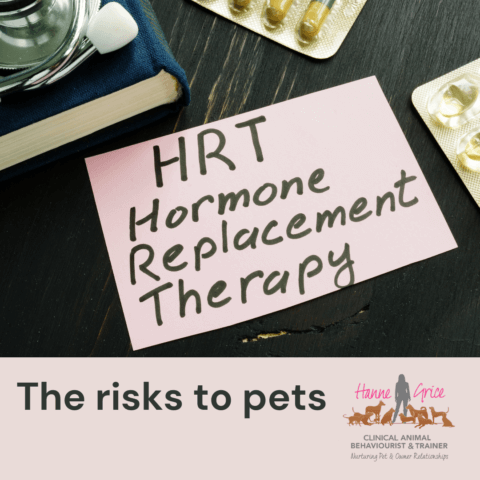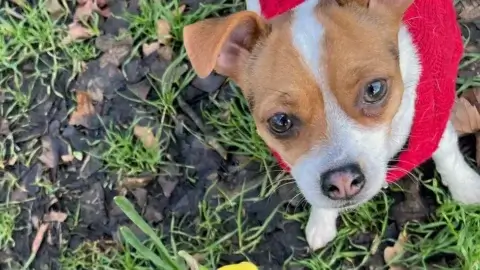
NOTE: It’s important to acknowledge that hormone replacement therapy (HRT) is vital for many individuals, including trans people and those experiencing menopause. The intention of this article is to highlight the potential risks of hormone transfer to animals, regardless of the source, to aid veterinary professionals in differential diagnoses. This should not be interpreted as a critique of HRT use or those who rely on it. Rather, the aim is to promote awareness of simple preventive measures that protect companion animals without stigmatising any group. Your input helps ensure these discussions remain inclusive and respectful.
As a Hormone Replacement Therapy (HRT) user, I am particularly interested in this subject matter; however, something I had not considered nor discussed with my doctor was whether my HRT could impact others, including my animals.
It is estimated that there are around 13 million perimenopausal or menopausal women in the UK; that equates to around one-third of the entire female population. Some of the most common symptoms include vasomotor symptoms (e.g., hot flushes and night sweats), breast tenderness, insomnia, migraines, and/or premenstrual dysphoria (Deecher, 2007).
Statistics from the NHS Business Services Authority show the number of patients prescribed Hormone Replacement Therapy (HRT) has risen by 35% from 2020/21 to 2021/2022, with around 1.93 million patients on HRT. It’s important to note that this figure does not include individuals treated privately.
What is Hormone Replacement Therapy? Hormone Replacement Therapy (HRT) is a treatment used to alleviate symptoms of menopause in women. It replaces hormones that are at a lower level as women approach and experience menopause. The preparations come in various forms, including gels, sprays, tablets, and patches. Gels and sprays are applied to clean, dry and unbroken skin. Gels are usually on the upper arm, shoulder or inner thigh, sprays on the inner arm, and patches placed below the waist, on the thigh, or buttock area.
HRT and animals
With over 12 million dogs living as pets in 31% of UK households and around 11 million cats living in 26% of UK households (UK Pet Food, 2023), it follows that a proportion of these animals will be living with owners or carers who may be on HRT.
Although HRT has been around since the 1940s, there is little data on HRT transference to others, including animals. Yet figures from the National Health and Nutrition Examination Survey found 61,169 dog and cat cases with exposure to dermatological topicals were recorded by the American Society for the Prevention of Cruelty to Animals (ASPCA) Animal Poison Control Center (APCC) (Tater et al., 2019).

HRT includes a range of products from tablets and patches to topicals like gels and sprays. Recently, several stories have highlighted the risk of HRT being absorbed by pets. For example, North Downs Specialist Referrals, a veterinary clinic based in Surrey, has recorded five cases of dogs being diagnosed with secondary exposure to HRT since the start of 2023. This included the case of Rosie, a Jack Russell terrier that appeared to come into season despite being spayed.
A search of the internet found another case that made headlines in the veterinary press in 2017; Lily, a 12-week-old female Dachshund, was found to be in season – in human children, we would call this precocious puberty.
Case studies have also been recorded relating to HRT toxicity in cats (Dresner et al., 2013; Tater et al., 2019). And, anecdotal evidence was put forward recently by one of my clients relating to her horse. However, there is even less data to support transference to horses, as much of the research has looked at young children and smaller animals like cats and dogs, given their closer and more frequent physical contact with adults within the home setting. Hence, young children, cats, and dogs are at greatest risk of HRT toxicity due to their size and early stage of development (Sjöström et al., 2022).
Different HRT products and considerations
I spoke with Menopause Specialist, Dr Carys Sonnenberg, about this subject to better understand what HRT products are available and how these might accidentally be transferred to our animals. From patches accidentally attaching themselves to pets’ paws, tablets being eaten, and gels being licked – check out the video below to learn more.
Signs to watch for if you suspect secondary exposure to HRT
It goes without saying that if you notice any changes with your animal’s behaviour or changes in their physical appearance, you must consult with your veterinarian, to rule out any possible medical conditions, including HRT toxicity.
Nevertheless, there are some signs you can look out for which might indicate that HRT transference is at play.
- In females:
- Enlarged vulva
- Bloody discharge from the vulva
- Raising of the hindquarters
- Uterine infection
- In males:
- Shrunken penis
- Small testes and/or undescended testicle in dogs 6+ months
- Inflamed penis
- In both sexes:
- Hair loss
- Increased interest from other dogs and or attraction towards others
- Enlarged mammary glands and or ulceration of the mammary glands
- Stunted growth
- Hypertrophied skin (scars)
- Excessive vocalisation
- Decreased appetite
- Extra-affectionate behaviour
- Inappropriate indoor urination
- Restlessness
- Aggression or other mood changes
- Vomiting and or diarrhoea
- Any other abnormal behaviour that is out of character for your animal
Considerations for animal professionals
It’s possible that secondary exposure to HRT can be overlooked as a differential diagnosis; for example, Sjöström et al. (2022) found that similar symptoms are observed in dogs with signs of ovarian remnant syndrome. And while awareness has grown over recent years about the impact pseudo pregnancy can have on entire and spayed female dogs, thanks to the great work of practitioners like Sara Davis (2023), considering whether HRT is at play may not be at the forefront of minds. Afterall, most practitioners would not necessarily discuss such intimate details with their clients unless the client raised this, or the subject came up organically in conversation.
Veterinary research recommends bloods are taken to examine oestradiol levels (regardless of gender) if HRT toxicity might be suspected, and ultrasonographic examination may help to rule out ovarian remnants in females. The latter examination would need to be performed by a highly experienced vet with a high-quality ultrasound machine and would need a referral to a specialist hospital. Indeed, I spoke with Sarah Keir, a veterinary surgeon and ultrasonographic specialist. Sarah said:
“Because ultrasonographic examination with a high-quality machine is not typically available to the majority of clinics, what is useful in cases where it is suspected hormonal changes may be at play, is conducting a blood test called anti-mullerian hormone test. This looks for any presence of ovarian or testicular tissue. This is available in the UK, very reasonably priced, and can be performed at any stage of a ‘cycle’. We also need to be aware of when oestrogen replacement treatment is used to treat urinary incontinence in bitches; the neutered bitch may appear like she is in oestrus, so this is another differential that would need to be ruled out.”
Sarah Keir, veterinary surgeon and ultrasonographic specialist
As part of this investigation into HRT secondary exposure, Sarah assisted me in gathering anecdotal evidence from other veterinary staff across the UK, via online forums. Below is an overview of the recent cases that had been encountered.
- Six cases of male neutered dogs with mammary development; one exhibiting excessive humping and lots of discharge, whilst another also had an enlarged prostrate
- Five cases of dogs with hair thinning and/or diagnosed with alopecia symptoms; one of these also had enlarged teats, this occurred after the owner had changed from oral HRT to transdermal
- One male, neutered Vizsla dog that showed signs of feminisation – the owner had recently started oestrogen gel
- Very young female puppy with a hugely enlarged vulva
- Two spayed cats that showed signs of oestrus and mammary development; one was a sphinx, potentially at greater risk where the animal is hairless
However, the majority of responses from the veterinary forums, suggested there was a general lack of awareness relating to the risk of secondary exposure to HRT.
So, for animal practitioners, perhaps discussions with clients should include unintrusive questioning to better understand if the animal comes into regular contact with anyone using HRT, having reviewed the clinical history when considering diagnostic differentials.
Considerations for GP practitioners
GPs and HRT specialists will warn of the possible transference to people, and HRT products contain instructional leaflets that highlight likely side effects and risks; a quick straw poll amongst my peers’ found conversations do not, typically, extend to the risk of HRT secondary exposure to pets.
So, I hope this article and conversations like that with Dr Carys, help to raise awareness of how we can mitigate for such risks, enabling patients to be treated effectively whilst continuing to enjoy safer interactions with their pets.
Useful websites
For Dr Carys Sonnenberg – Menopause Specialists | Menopause Clinic | Rowena Health
For Sarah Keir – VetArtis – Using the Art of Medicine
For registered Clinical Animal Behaviourists and Veterinary Behaviourists – ABTC – Animal Behaviour & Training Council
References
- Davis, S. Pseudopregnancy in spayed bitches – a preventable welfare problem. Veterinary Practice. 2023. Available at: https://www.veterinary-practice.com/article/pseudopregnancy-in-spayed-bitches. Accessed 25 October 2023
- Deecher DC, Dorries K. Understanding the pathophysiology of vasomotor symptoms (hot flushes and night sweats) that occur in perimenopause, menopause, and postmenopause life stages. Arch Womens Ment Health. 2007;10(6):247-57. doi: 10.1007/s00737-007-0209-5. Epub 2007 Dec 12. PMID: 18074100.
- Dresner EO, Norsworthy GD. Estrus in a spayed cat. Todays Vet Pract. 2013: 61–3. Available from: https://todaysveterinarypractice.com/wp-content/uploads/sites/4/2016/09/T1303C07.pdf. Accessed 25 October 2023
- Ganz S, Wehrend A. Uptake of exogenous estrogen as a differential diagnosis of ovarian-remnant-syndrome in a bitch: a case report. BMC Vet Res. 2021; 17(1): 225. https://doi.org/10.1186/s12917-021-02923-9
- Kopper NW, Gudeman J, Thompson DJ. Transdermal hormone therapy in postmenopausal women: a review of metabolic effects and drug delivery technologies. Drug Des Devel Ther. 2008 Feb 6;2:193-202. doi: 10.2147/dddt.s4146. PMID: 19920906; PMCID: PMC2761184.
- Lau, E. Hormone replacement skin products affect users’ pets, confound veterinarians. VIN News Service. 2010. Available at: https://news.vin.com/default.aspx?pid=210&Id=4523143&useobjecttypeid=10&fromVINNEWSASPX=1&f5=1. Accessed 25 October 2023
- Sjöström, K. et al. (2022). A review of adverse events in animals and children after secondary exposure to transdermal hormone‐containing medicinal products. Veterinary Record Open, 9(1). doi:10.1002/vro2.48.
- Tater KC, Gwaltney-Brant S, Wismer T. Dermatological topical products used in the US population and their toxicity to dogs and cats. Vet Dermatol. 2019; 30(6): 474-e140. https://doi.org/10.1111/vde.12796
- UK Pet Food. UK pet population, UK Pet Food. 2023. Available at: https://www.ukpetfood.org/information-centre/statistics/uk-pet-population.html Accessed 25 October 2023
- Wiener DJ, Rüfenacht S, Koch HJ, Mauldin EA, Mayer U, Welle MM. Estradiol-induced alopecia in five dogs after contact with a transdermal gel used for the treatment of postmenopausal symptoms in women. Vet Dermatol. 2015; 26(5): 393–6, e90-1. https://doi.org/10.1111/vde.12242
Learn more about our classes

Get Hanne's book, clothing and more
Hanne has a number of publications including her book Playing With Your Dog to help owners work out the games that are best suited for their pet to play throughout his life, from puppyhood to old age, available from Amazon. Check out Hanne's range of contemporary casuals The Collection – for pet lovers made from recyclable, organic materials that are sustainably sourced.

